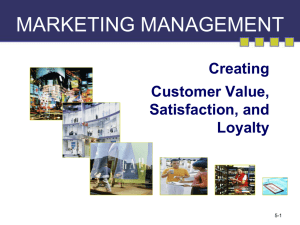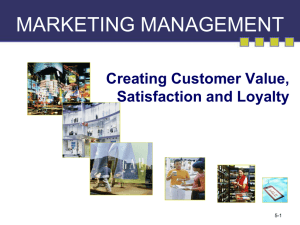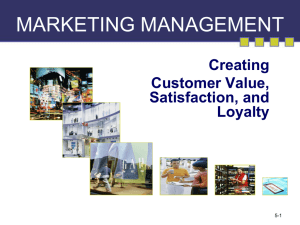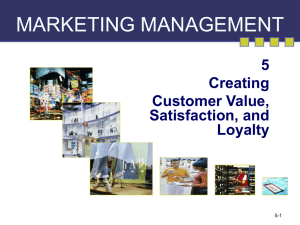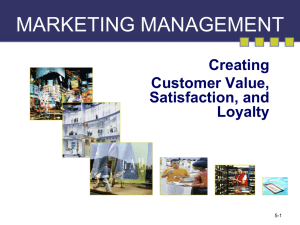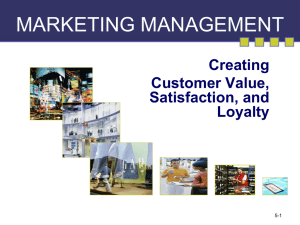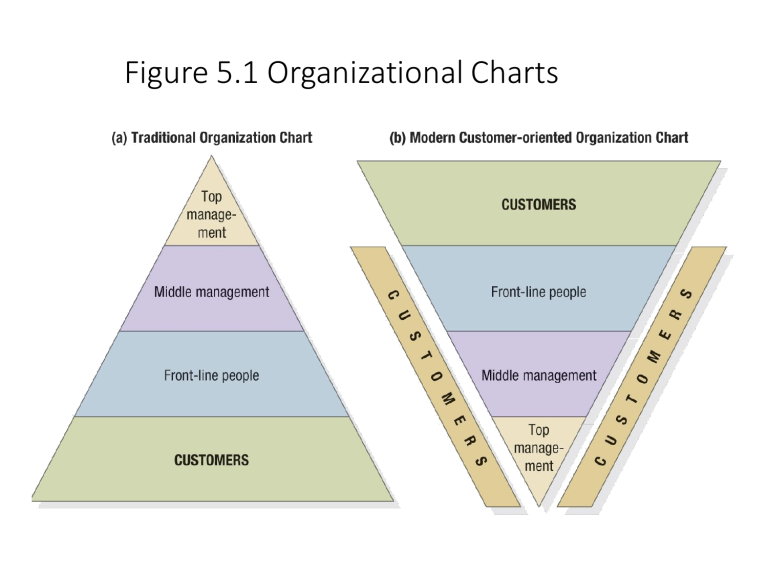
Figure 5.1 Organizational Charts What is Customer Perceived Value? •Consumers are better educated and informed than ever •Customer perceived value is the difference between the prospective / future customer’s evaluation of all the benefits and all the costs of an offering and the perceived alternatives. Determinants of Customer Perceived Value Total customer benefit Total customer cost Product benefit Monetary cost Services benefit Time cost Personnel benefit Energy cost Image benefit Psychological cost •TCB is perceived value of economic, functional and psychological benefits customer expect from market offering. •TCC is perceived bundle of costs customers expect to incur in evaluating , obtaining, using given market offering , energy and psychological costs. The Marketing Funnel Steps in a Customer Value Analysis 1. Identify major attributes and benefits that customers value 2. Assess the qualitative importance of different attributes and benefits 3. Assess the company’s and competitor’s performances on the different customer values against rated importance 4. Examine ratings of specific segments 5. Monitor customer values over time What is Loyalty? Loyalty is a deeply held commitment to re-buy a preferred product or service in the future despite situational influences and marketing efforts having the potential to cause switching behavior. The Value Proposition The whole cluster of benefits the company promises to deliver Total Customer Satisfaction • Satisfaction is person’s feeling of pleasure or disappointment that result from comparing product’s perceived performance to expectation. • Performance falls short of expectation customer is dissatisfied. • If it matches expectation customer is satisfied. Measuring Satisfaction Periodic Surveys Customer Loss Rate Monitor Competitive Performance Single Key Question of Net Promoter “How likely is it that you would recommend this product or service to a friend or colleague?” Use 0-10-point scale 0-6 are Marketers than subtract Detractors 7-8 are deemed Passively satisfied 9-10 are Promoter (Net Promoter ScoreNPS) World class companies used NPS Customer Satisfaction Customer Loyalty Company’s Profit What is Quality? •Quality is the totality of features and characteristics of a product or •service that bear on its ability to satisfy stated or implied needs. Maximizing Customer Lifetime Value Customer Profitability Customer Equity Lifetime Value Customer-Product Profitability Analysis What can company do for customer 2 & 3 ? •It can raise the price of less profitable product or eliminate them •It can try to sell customer 2 & 3 its profit making products. Customer Lifetime Value (Formula Page No: 116) • CLV described net present value of stream of future profits expected over customer’s lifetime purchase. What is Customer Relationship Management? • CRM is the process of carefully managing detailed information about individual customers and all customer touchpoints to maximize customer loyalty. • CRM enables companies to provide excellent real time customer service through effective use of individual account information. Personalizing Marketing • It is about making sure the brand and its marketing are relevant as possible to as many customer as possible – a challenge , given that no two customers are identical. • E commerce companies looking to attract and retain customers are discovering that personalization goes beyong creating customized information. Framework for CRM Identify prospects and customers (maintain your customer database) Differentiate customers by needs & value to company Interact to improve knowledge Customize for each customer Reducing Defection • It is not enough to attract new customer; company must also keep them and increase business. • Too many companies suffer from high customer churn or defection. • Ex. Telecom MNP introduce in India • To Reduce defection rate companies must • Define and measure defection rate • Differentiate causes of customer attrition and identify those that can be managed better • Compare lost customer’s lifetime value to cost of reducing defection rate Retention Dynamics • Main steps in attracting and retaining customers in terms of funnel and some questions to measure progress through the funnel. • The marketing funnel identifies the % of potential target market at each stage in decision process, from merely aware to high loyal. • Customer must move through each stage to become loyal. Building Loyalty • Creating a strong , tight connection to customer is dream of any marketer and often the key to long term marketing success. • Following sections explain 3 types of marketing activities companies are using to improve loyalty and retention. 1. Interacting with customers 2. Developing Loyalty Programs 3. Creating institutional Ties Customer Retention • Acquisition of customers can cost five times more than retaining current customers. • The average customer loses 10% of its customers each year. • A 5% reduction to the customer defection rate can increase profits by 25% to 85%. • The customer profit rate increases over the life of a retained customer.
